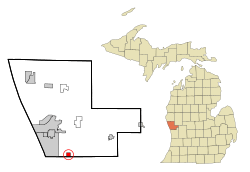Fruitport, Michigan facts for kids
Quick facts for kids
Fruitport, Michigan
|
|
|---|---|
|
Village
|
|

Location of Fruitport, Michigan
|
|
| Country | United States |
| State | Michigan |
| County | Muskegon |
| Area | |
| • Total | 1.02 sq mi (2.63 km2) |
| • Land | 0.91 sq mi (2.35 km2) |
| • Water | 0.11 sq mi (0.28 km2) |
| Elevation | 627 ft (191 m) |
| Population
(2010)
|
|
| • Total | 1,093 |
| • Estimate
(2019)
|
1,149 |
| • Density | 1,266.81/sq mi (488.85/km2) |
| Time zone | UTC-5 (Eastern (EST)) |
| • Summer (DST) | UTC-4 (EDT) |
| ZIP code |
49415
|
| Area code(s) | 231 |
| FIPS code | 26-31000 |
| GNIS feature ID | 0626541 |
| Website | http://www.villageoffruitport.com/ |
Fruitport is a village in Muskegon County in the U.S. state of Michigan. The population was 1,093 at the 2010 census. The community is located within Fruitport Charter Township.
Water and sewer utilities are provided by Fruitport Charter Township.
Fruitport is also known for its athletic programs, mainly from its successes in volleyball and wrestling. In volleyball, since 2001, the program has been a state finalist eight times, winning three state titles (2005, 2010, and 2011). In football the team in 2001 were state runners-up. The football program also produced Mike Teeter, who played defensive end at the University of Michigan, and in the NFL for the Minnesota Vikings and the Houston Oilers. In wrestling, the team has won two of the last three district titles, and has had a number of state qualifiers over the years, including sending six wrestlers to the state championships in 2014,.
Fruitport was founded by Edward L. Craw in 1868, who platted and named it as Crawville. It was renamed Fruitport a year later when the Pere Marquette Railroad built a station there, as the town was in the middle of a fertile fruit growing area and also a port. It incorporated as a village in 1891.
In an election on November 8, 2005, 306 residents voted to dissolve the village municipal corporation, while 155 voted no. However, a two-thirds majority (308 votes) was needed to dissolve the village. This was the fourth time since 1979 that a proposal to dissolve the village was on the ballot for an election. In 1990, a proposal to disincorporate was defeated by a 2 to 1 margin while a proposal in 1998 failed by 41 votes.
Contents
Geography
According to the United States Census Bureau, the village has a total area of 1.02 square miles (2.64 km2), of which 0.91 square miles (2.36 km2) is land and 0.11 square miles (0.28 km2) is water.
Demographics
| Historical population | |||
|---|---|---|---|
| Census | Pop. | %± | |
| 1880 | 353 | — | |
| 1900 | 311 | — | |
| 1910 | 330 | 6.1% | |
| 1920 | 321 | −2.7% | |
| 1930 | 379 | 18.1% | |
| 1940 | 458 | 20.8% | |
| 1950 | 638 | 39.3% | |
| 1960 | 1,037 | 62.5% | |
| 1970 | 1,409 | 35.9% | |
| 1980 | 1,143 | −18.9% | |
| 1990 | 1,090 | −4.6% | |
| 2000 | 1,124 | 3.1% | |
| 2010 | 1,093 | −2.8% | |
| 2019 (est.) | 1,149 | 5.1% | |
| U.S. Decennial Census | |||
2010 census
As of the census of 2010, there were 1,093 people, 440 households, and 312 families residing in the village. The population density was 1,201.1 inhabitants per square mile (463.7/km2). There were 476 housing units at an average density of 523.1 per square mile (202.0/km2). The racial makeup of the village was 95.8% White, 1.5% African American, 0.2% Native American, 0.4% Asian, 1.1% from other races, and 1.1% from two or more races. Hispanic or Latino of any race were 2.0% of the population.
There were 440 households, of which 31.6% had children under the age of 18 living with them, 55.9% were married couples living together, 10.2% had a female householder with no husband present, 4.8% had a male householder with no wife present, and 29.1% were non-families. 23.0% of all households were made up of individuals, and 10.7% had someone living alone who was 65 years of age or older. The average household size was 2.48 and the average family size was 2.91.
The median age in the village was 43.6 years. 22.5% of residents were under the age of 18; 6.1% were between the ages of 18 and 24; 23.5% were from 25 to 44; 31.6% were from 45 to 64; and 16.3% were 65 years of age or older. The gender makeup of the village was 50.2% male and 49.8% female.
Climate
This climatic region is typified by large seasonal temperature differences, with warm to hot (and often humid) summers and cold (sometimes severely cold) winters. According to the Köppen Climate Classification system, Fruitport has a humid continental climate, abbreviated "Dfb" on climate maps.
Education
The village is located in the Fruitport Community Schools district, which also serves Fruitport Charter Township. Fruitport High School, Fruitport Middle School, and Edgewood Elementary School serve the village. Also located near the village is the private Calvary Christian School.
See also
 In Spanish: Fruitport para niños
In Spanish: Fruitport para niños

